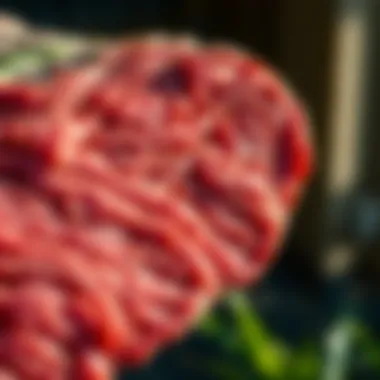Exploring Grass-Fed Direct: A Consumer-Centric Approach


Intro
In the past decade, the conversation surrounding food production has shifted dramatically, pivoting toward a renewed focus on sustainable practices and direct consumer relationships. Farming is no longer just about cultivating crops or raising livestock; it's about understanding the full scope of food systems, including the well-being of animals, the health of the land, and, crucially, the quality of food reaching the consumer. This narrative will explore the dynamics of grass-fed direct, emphasizing its significance in today’s agricultural landscape. By examining its financial, environmental, and social implications, we hope to shed light on what this model means for both producers and consumers.
Latest Trends in Agriculture
Overview of Current Trends
The agricultural arena is evolving, with several pivotal trends garnering attention. One prominent shift is the preference for transparency in food sourcing. Consumers are increasingly opting for products that they can trace back to their origins. They want to know how animals are raised and treated. This trend aligns well with the grass-fed direct model, which promotes direct sales from farmers to consumers, minimizing the layers in the supply chain. With a focus on ethical farming methods, buyers are leaning more towards grass-fed options as they relate to animal welfare and environmental conservation.
Another noteworthy trend involves regenerative agriculture, a practice that aims to restore soil health and biodiversity. Grass-fed livestock are often integrated into these systems, as their grazing patterns can help revitalize pastures. Consumers are starting to become familiar with terms like "regenerative" and "carbon farming," acknowledging that their food choices can contribute to broader environmental causes. This awareness points toward a transformative shift in how people regard their eating habits and their responsibilities to both the planet and its inhabitants.
Impact of Technology on Farming Practices
Modern technology has infiltrated agriculture in various forms, presenting both advantages and challenges. Precision farming, utilizing GPS and data analytics, allows farmers to tailor their practices to suit the needs of their land on an incredibly granular level. For grass-fed operations, this can mean optimizing pasture growth and animal health on an individual basis. Additionally, technologies like blockchain provide transparency in animal sourcing, helping consumers verify their food's origins more easily.
Farming apps, drones, and sensors are now commonplace, assisting farmers in monitoring livestock health and soil conditions efficiently. While these advancements can significantly enhance productivity and sustainability, they may also require an initial investment that smaller farms might find daunting. However, the potential to connect directly with consumers, showcasing the benefits of grass-fed products—like taste and health—is a compelling motivator for many farmers to adopt these technologies.
Sustainable Practices: Towards a Greener Future
Importance of Sustainability in Agriculture
Sustainability is no longer just an industry buzzword; it's become a central pillar of modern agricultural practices. With growing concerns about climate change and food security, the emphasis on sustainable farming is paramount. Consumers expect accountability not just from brands but also from farmers. They want to purchase products that align with their beliefs about health, the environment, and ethics.
Grass-fed direct farms often prioritize practices that contribute to building sustainable systems. By optimizing grazing methods and integrating crop rotation, they can improve soil fertility and reduce the need for synthetic fertilizers, which can have harmful environmental impacts.
Methods for Sustainable Farming
Implementing sustainable methods isn’t a one-size-fits-all strategy. Farmers must tailor practices to their specific ecological contexts and market demands. Some effective methods in the grass-fed model include:
- Rotational Grazing: This practice involves moving livestock between pastures to prevent overgrazing, allowing grasslands to recover and contribute more robustly to carbon sequestration efforts.
- Integrated Pest Management: Instead of relying solely on chemical pesticides, this approach combines biological pest control, habitat manipulation, and mulching, promoting a balanced ecosystem.
- Cover Cropping: Planting cover crops during the off-season can improve soil health, prevent erosion, and enhance the farm’s biodiversity.
These methods illustrate that sustainable approaches to agriculture not only benefit the environment but can also enhance food quality and farmer profitability.
Ending
By exploring these dynamics within grass-fed direct practices, we’ve not only illuminated the challenges and rewards faced by both producers and consumers but have also placed a spotlight on critical trends shaping the future of agriculture. It’s clear that embracing these new dimensions in food production is essential for ensuring a resilient and transparent food system that meets both consumer expectations and environmental needs.
For more insights on trends in agriculture, you can visit resources such as Wikipedia for a general overview, and engaging discussions on Reddit may offer a community perspective. Additionally, articles from institutions like britannica.com provide valuable historical contexts to these evolving practices.
Understanding Grass-Fed Direct
Grass-fed direct represents an evolving paradigm in agricultural practices that emphasizes direct consumer access to grass-fed livestock. In layman's terms, it’s an approach focused on farming that cuts out middlemen, allowing consumers to purchase meat products directly from farmers. This connection fosters transparency, enabling buyers to understand exactly where their food comes from and how it was raised. Such an arrangement is increasingly gaining traction, not just among health-conscious consumers but also among those who are concerned about sustainability and ethical farming practices.
This section dives deep into the importance of grasping the dynamics behind grass-fed direct. Understanding this model is crucial for farmers looking for alternative revenue streams, as well as consumers who prioritize the nutritional and ethical aspects of their food choices. Embracing grass-fed products directly can lead to a more sustainable agricultural future, benefiting both producers and consumers alike.
Definition of Grass-Fed
When it comes to defining "grass-fed," many folks often imagine pastures brimming with lush greenery where cattle roam freely. The term signifies livestock that have been predominantly fed grass as opposed to grain. However, the definition can be shrouded in ambiguity, as regulations vary by country and region. In the United States, the USDA has specific guidelines that farmers must adhere to for products to be labeled grass-fed. Generally speaking, to be considered truly grass-fed, livestock should have access to fresh grass or forage throughout their lives, with minimal supplementation of grains.
This model not only enhances the well-being of the animals but also boasts a slew of health benefits for consumers. Grass-fed meat is known to be higher in omega-3 fatty acids, CLA, and vitamins A and E compared to its grain-fed counterparts. Through direct sales, consumers can ensure the authenticity of grass-fed claims, matching their buying choices with their values and health goals.
Origins of Direct Sales in Agriculture
The rise of direct sales in agriculture can be traced back to the simple premise of community and connection. Historically, farmers sold their produce to local markets or cooperatives that facilitated distribution. Over time, the model evolved, especially with the advent of technology, creating opportunities for farmers to sell directly to consumers.
This approach not only caters to the desires of consumers for fresher and higher quality products but also empowers farmers. By eliminating intermediaries, producers can fetch better prices for their goods, ensuring more of the profits go back to the people who actually grow the food.


Here are some reasons why this shift matters:
- Local Economies: Strengthening local economies by supporting regional farmers.
- Transparency: Creating a clear line of accountability between producer and consumer.
- Quality Control: Allowing farmers to maintain product quality and adhere to personalized standards.
Grass-fed direct reflects a broader movement toward food sovereignty—a concept where communities have the right to choose their food sources and agricultural practices. It's a return to roots, nurturing not just the land but also the bonds between consumers and the folks who put food on their tables.
"Knowledge of the source and method of food production is a step towards a healthier community and planet."
This understanding leads us to appreciate why adopting grass-fed direct practices can be transformative for agricultural stakeholders looking to adapt to modern demands.
The Benefits of Grass-Fed Direct
When examining grass-fed direct models, several pivotal benefits surface. Understanding these advantages can enlighten both consumers and producers alike, showing how this approach reshapes the agricultural landscape and contributes to healthier food systems. Here, we delve into some specific elements that enhance the appeal of grass-fed direct, revealing its multifaceted importance.
Nutritional Advantages
One of the most talked-about benefits of grass-fed animals is the nutritional value of their products. Grass-fed beef, for example, is often touted as a more healthful choice compared to grain-fed counterparts. Research indicates that grass-fed beef tends to have higher levels of omega-3 fatty acids, vitamin E, and conjugated linoleic acid (CLA), which are beneficial for heart health and have anti-inflammatory properties. While both types of beef provide protein, consumers seeking health-conscious options may lean towards grass-fed due its nutrient density.
A study published in the Journal of Animal Science reveals that grass-fed beef can have approximately 30% more omega-3s than grain-fed beef, emphasizing significant health benefits for enthusiasts.
Additionally, the unique flavor profiles of grass-fed products are often noted by chefs and culinary aficionados. The diet of grass-fed livestock influences the taste and texture of meat—a genuine farm-to-table experience that defines this model. With the growing health trends, consumers are more aware and demand products that offer higher nutritional value, and grass-fed direct clearly rises to the occasion.
Economic Implications for Farmers
Grass-fed direct not only provides health advantages for consumers but also presents distinct economic benefits for farmers. Transitioning to grass-fed practices can sometimes demand a bit of a learning curve and initial investment. However, many farmers find that this model opens new revenue streams through direct sales.
- Farmers can sell products at a premium price due to the perceived higher quality and health benefits of grass-fed products.
- Engaging in direct sales eliminates middlemen, allowing producers to retain a larger share of profits.
- They also build relationships with consumers who often return for repeat purchases, creating a loyal customer base.
Rural economies may benefit significantly from the grass-fed direct model as more consumers prioritize locally sourced food. This approach stimulates local business while displaying a transparency that larger corporate entities often lack. Consequently, farmers do not just see a monetary improvement but a holistic transformation in how they relate to their community and market.
Enhanced Sustainability Practices
Perhaps one of the most compelling aspects of the grass-fed direct model is its emphasis on sustainable practices. Grass-fed systems often encourage biodiversity and promote healthier ecosystems. By rotating grazing animals, farmers can rejuvenate soils and reduce the need for synthetic fertilizers. The result? Healthier forage, improved carbon sequestration, and reduced greenhouse gas emissions.
- Grazing helps maintain open lands, preventing the encroachment of invasive species.
- Enhanced soil health contributes to water quality, minimizing runoff and promoting a balanced ecosystem.
- Animals raised in these systems tend to be healthier, reducing the reliance on antibiotics and promoting animal welfare.
These practices not only contribute to a more sustainable agricultural system but also resonate with eco-conscious consumers. Many buyers today seek products that align with their values, and grass-fed direct models often resonate strongly due to their emphasis on environmental stewardship and humane treatment of livestock.
In summary, the benefits of grass-fed direct are as numerous as they are compelling. From notable nutritional advantages to economic enhancements for farmers, and a resolute commitment to sustainability, this model nurtures a more robust food system. Understanding these facets helps pave the way for a broader discussion among agricultural stakeholders about the future of food production.
Challenges Within Grass-Fed Direct Models
Grass-fed direct models have gained popularity but face certain hurdles that can impede their growth and sustainability. Understanding these challenges is crucial for farmers, consumers, and stakeholders aiming for an efficient agricultural system that satisfies both needs and ethics. Addressing the unique difficulties within this model represents an important knowledge area, and a closer examination can reveal steps towards better practices.
Market Access and Competition
One of the primary challenges for grass-fed direct models is limited market access. Farmers often find themselves at the mercy of local demand, which can fluctuate unpredictably. When direct selling channels are restricted, producers may struggle to find a dependable customer base regarding grass-fed products. Large agribusinesses dominate the market, making it daunting for smaller farmers to compete.
To navigate this landscape, farmers must explore diverse strategies to enhance their visibility. Participating in farmers' markets or community-supported agriculture (CSA) programs can help reach conscientious consumers. Digital marketing tools and social media provide platforms for farmers to share their story and connect with health-conscious buyers.
- Fostering Local Networks: Building connections with nearby restaurants and grocery stores can create valuable partnerships.
- Niche Marketing: Emphasizing the unique aspects of grass-fed products differentiates producers from conventional options.
Overcoming market access obstacles involves consistent strategies and community engagement to assure that grass-fed products find their rightful place on consumers' tables.
Consumer Awareness and Education
Though awareness around the benefits of grass-fed options is creeping into the public's consciousness, many consumers remain uninformed. Misinformation about the quality, nutritional value, and even the price of grass-fed products can turn potential buyers away. Educating consumers on why grass-fed is a worthy choice goes beyond mere advertising; it requires a well-thought-out strategy.


Farmers and producers should aim to disseminate credible information about:
- Nutritional Benefits: Highlight how grass-fed products are often richer in omega-3 fatty acids and vitamins compared to grain-fed counterparts.
- Environmental Impact: Share insights about sustainable practices and reduced carbon footprints associated with grass-fed livestock.
- Animal Welfare: Educate consumers on humane treatment and the ethical considerations related to pasture-raised animals.
Presenting well-rounded information can help in developing a more informed customer base, eager to invest in what they understand deeply.
Regulatory Barriers
Navigating the regulatory landscape is yet another hurdle in grass-fed direct models. Regulations surrounding animal welfare, labeling, and product processing can be complex and disheartening for small-scale producers. Inconsistencies in what defines “grass-fed” across different jurisdictions can lead to confusion and distrust among consumers.
- Compliance Requirements: Farmers often invest significant time and resources into ensuring they meet all state and federal regulations, diverting attention from farming itself.
- Labeling Confusion: Without a clear definition of what grass-fed entails, consumers may find it hard to differentiate quality products.
Proactive engagement with local agricultural departments and keeping abreast of relevant legal changes is essential to helping producers navigate such challenges. Collaborative discussions with policymakers can also lead to better regulations that promote and support grass-fed models as viable alternatives.
Understanding the challenges that farmers face in the grass-fed direct model is essential for envisioning successful strategies to foster sustainability in agriculture.
Overcoming these challenges requires cooperation among stakeholders, insights from successful models, and persistent efforts to enhance consumer knowledge. Armed with the right tools and information, farmers can rise above these challenges and contribute to a blossoming market for grass-fed products.
The Role of Technology in Grass-Fed Direct
In recent years, technology has forged a powerful path for transforming the grass-fed direct model, significantly reshaping how producers and consumers interact. Utilizing cutting-edge tools not only streamlines processes but also enhances transparency and accessibility, ultimately elevating the entire agricultural landscape. Therefore, understanding this role is crucial for farmers engaged in or considering this model, as technology offers numerous advantages while posing distinct challenges to navigate.
E-Commerce and Direct Marketing Strategies
One of the standout developments in grass-fed direct is the rise of e-commerce platforms. Today, farmers can readily connect with consumers right from their own pastures. Gone are the days where one had to rely solely on local markets or physical retail spaces. Instead, online marketplaces, social media platforms, and dedicated agricultural apps play an essential role in enabling producers to market their grass-fed products effectively.
Moreover, direct marketing strategies are evolving. Farmers are no longer just selling beef or lamb; they are selling a story, a lifestyle, and the peace of mind that comes from knowing where food comes from. These strategies can include:
- Digital storytelling through blogs, allowing producers to share their journey in grass-fed farming.
- Using social media channels like Facebook and Instagram for visually captivating content that showcases the farm's practices and benefits of grass-fed products.
- Implementing email newsletters to regularly update consumers on new products, seasonal availability, and farm events.
Utilizing these e-commerce platforms effectively lays down a foundation for building brand loyalty. Consumers are increasingly drawn to businesses that prioritize transparency. E-commerce allows farmers to share not only the product but also their farming methods, animal welfare practices, and commitment to sustainability.
Traceability in Supply Chains
Traceability is becoming a cornerstone of consumer preference, especially in the grass-fed market. The ability for consumers to know where their food originates fosters trust, a vital component in today’s market. Technology plays a key part in enhancing traceability, with blockchain technology emerging as a notable player. This allows producers to verify and communicate the journey of their products from farm to table.
Key benefits include:
- Improved Communication: Farmers can provide consumers with immediate access to data about their meat, including what the animals were fed, their living conditions, and transportation details.
- Quality Assurance: By implementing robust tracking mechanisms, farmers can quickly address any concerns or recalls, ensuring a safer product.
- Consumer Confidence: Providing easy access to information validates a producer's claims about their grass-fed practices, creating informed consumers who are more likely to purchase and support local farms.
Consumer Perspectives on Grass-Fed Products
Consumer attitudes towards grass-fed products can shape the future of agricultural practices, making this topic essential in understanding the broader dynamics of grass-fed direct. Awareness of the health benefits commonly associated with these products drives interest, influencing purchasing decisions and establishing trends. Furthermore, as consumers aim to align their eating habits with a growing awareness of sustainability, the intricacies of their perspectives offer essential insights for producers.
Health Consciousness and Trends
Consumers today are more health-conscious than ever. With information at their fingertips, they often turn to grass-fed products, believing they offer a more nutritious alternative to traditional meat sources. Research has shown that grass-fed beef contains higher levels of omega-3 fatty acids and vitamins like E and A, crucial for maintaining overall health. As a result, many consumers view these products not just as food, but as part of a healthy lifestyle. They consider:
- Perceived Nutritional Value: The belief that grass-fed livestock yield healthier meat. For many, this is not just a marketing angle, but a crucial part of their everyday diet.
- Holistic Well-Being: These products are often associated with not only personal health, but also the ethical treatment of animals, which speaks to consumers’ growing desire for responsible food sourcing.
- Trends in Health Movements: From paleo diets to keto trends, there’s a rising wave of dietary fads that promote the consumption of grass-fed meat, linking it to various health benefits.
Overall, the importance consumers place on health has created a ripe environment for the growth of grass-fed offerings in the market, significantly influencing farmers to adapt their practices to meet this demand.
Perception of Value and Quality
When discussing grass-fed products, the notion of value transcends mere economics. It taps into a broader narrative about quality, safety, and environmental concerns. Many consumers are willing to pay a premium for products they perceive as superior. This perception often breaks down into several key factors:
- Quality Over Quantity: Shoppers perceive grass-fed meat as having a richer flavor and superior texture compared to grain-fed options. This idea resonates with both gourmet enthusiasts and everyday buyers alike, driving preference in many purchase decisions.
- Sustainability and Ethics: Consumers increasingly link their choices with their values, favoring products that endorse sustainable and ethical farming practices. Grass-fed products often come with claims of animal welfare and environmental benefits that align with their ethical considerations.
- Education and Transparency: Access to information is fueling a desire for transparency. Many consumers now look for detailed sourcing information and will gravitate towards brands that prominently showcase their practices, fostering trust.


"Value is intricately tied to personal principles. For many, choosing grass-fed isn’t just about nutrition; it’s a pledge to support ethical practices and sustainability."
As more consumers prioritize transparency, they are actively seeking out information about the farming and production processes behind grass-fed products. This growing demand for knowledge not only affects consumer choices but can also reflect broader societal shifts towards more responsible consumption.
Case Studies in Grass-Fed Direct
The exploration of case studies in grass-fed direct is not just a window into successful practices; it’s a rich repository of real-world experiences that inform both current and future models of grass-fed agriculture. By examining specific examples, we can glean insights into the factors that contribute to successful implementation, as well as the pitfalls that need careful navigation. This section aims to showcase models from different regions and to derive lessons from the challenges these ventures have faced.
Successful Models from Different Regions
In various corners of the globe, farmers have harnessed the potential of grass-fed direct approaches successfully. Here are some noteworthy models:
- The Australian Paradigm: In Australia, various farms are adopting grass-fed practices that directly connect consumers to producers. The emphasis on local markets reduces transportation costs, making products more accessible. For instance, Riverine Farms leverages a direct-to-consumer model, emphasizing high-quality beef raised on natural pastures. Their online platform not only facilitates sales but also creates a community of loyal customers who appreciate the transparency of the sourcing process.
- The American Success Story: In the United States, White Oak Pastures has established itself as a leader in the grass-fed direct market. Located in Georgia, this farm integrates regenerative agricultural practices while focusing on direct sales to consumers. They sell products through an online store and also offer subscription services that cater to consumers interested in regular deliveries of grass-fed meat. The farm showcases its practices through tours and events, further enhancing customer trust and engagement.
- The European Model: In the UK, Coombeshead Farm provides an interesting example with their farm-to-table model. By partnering with local restaurants, they not only sell grass-fed beef but also provide a unique dining experience that educates consumers on the benefits of grass-fed meat. This model has successfully tapped into the growing trend of sustainable eating among consumers.
These examples illustrate the diverse strategies employed across different regions, revealing how local conditions, consumer preferences, and regulatory environments shape the grass-fed direct approach.
Lessons Learned from Challenges
The journey in grass-fed direct models hasn’t been all sunshine and roses. It is crucial to learn from challenges that these case studies present. The insights drawn from their experiences can be transformative for aspiring farmers and stakeholders:
- Market Penetration Difficulties: One recurring challenge faced by farms like White Oak Pastures and others has been penetrating market spaces saturated with conventional options. Grass-fed products often come with a price premium due to the costs associated with sustainable practices. Successful businesses emphasize the importance of educating consumers about the benefits of grass-fed meat and the environmental impact of their choices.
- Balancing Supply and Demand: Some farms have struggled with maintaining an equilibrium between supply and demand. For instance, during periods of heightened awareness around health and sustainability, suppliers have found themselves unable to meet consumer demand, leading to missed opportunities. Creating scalable and flexible production strategies can help mitigate this issue.
- Navigating Regulations: Farmers like those at Coombeshead Farm have had to navigate complex and sometimes restrictive agricultural regulations that can impede their direct sales efforts. Understanding the intricacies of local food regulations is paramount in establishing effective distribution channels.
Future Trends in Grass-Fed Direct
The landscape of grass-fed direct is continually evolving. This section explores the future trends expected to shape the grass-fed farming model. Such trends bear significant implications for producers and consumers alike, as they inform how both interact with the market. As awareness of sustainable practices increases among consumers, grass-fed farmers must adapt accordingly to meet new demands. The growing interest in health-conscious eating encourages not just farms to reevaluate their operations, but also pushes for innovations that enhance productivity and sustainability.
Innovations in Farming Practices
Innovations in farming practices are critical to keeping up with the changing climate and consumer behavior. Many farmers are adopting regenerative agricultural practices, focusing on long-term soil health and the ecosystem rather than short-term yields. A prominent example involves integrating animal and plant production systems. This might include rotating livestock with crops to promote biodiversity and improve soil health, which in return, enhances the nutritional profiles of the products.
In addition to regenerative techniques, technology plays a vital role. Precision agriculture, utilizing satellite imagery and data analysis, can help farmers monitor soil health and optimize grazing patterns. Moreover, vertical farming techniques are being employed to enhance productivity while using fewer resources. Leveraging these innovations can lead to better product quality and, ultimately, higher consumer satisfaction.
"Innovation in farming isn’t just about technology, it’s about having the smarts to use what you have more wisely."
Some farmers are even experimenting with aquaponics, where fish and plants are grown together in a symbiotic relationship, reducing water usage and increasing yield efficiency. Such innovations may appear niche now, but as competition in the market intensifies, these methods may soon become more mainstream among grass-fed producers.
The Role of Climate Change in Future Adaptations
Climate change is no longer looming on the horizon; it is here, knocking on every farmer's door. As weather patterns become more erratic, adaptability is more crucial than ever. Farmers must find ways to cope with challenges such as droughts, flooding, or rising temperatures. This could mean altering grazing schedules or diversifying crops to ensure that they can produce even under shifting climatic conditions.
Grass-fed farmers are increasingly looking towards climate-smart agriculture. Practices that sequester carbon in the soil not only mitigate the impact of greenhouse gases but can also enhance soil health, making farms more resilient. Utilization of cover crops is another adaptation strategy. These crops protect the soil during non-growing seasons, preventing erosion and improving water retention.
The role of governmental regulations cannot be overlooked. Frameworks supporting sustainable practices incentivize farmers to adopt climate-friendly methods. Understanding shifts in policy can help farmers anticipate changes in practices mandated by legislation, thus staying ahead of the competition.
As awareness grows about the impact of livestock on climate change, some producers are also exploring alternative protein sources. With more consumers interested in plant-based diets, farmers may need to adapt by growing complementary crops such as legumes or pulses alongside their grass-fed livestock operations. This not only diversifies their income but also addresses the rising demand for sustainable protein sources.
In summary, the future of grass-fed direct lies in innovative farming practices and the necessary adaptations to climate change. These trends reflect a learning process deeply rooted in sustainability, aiming for a mutually beneficial relationship between the land and its stewards.
Closure
The significance of the conclusion in this article takes layers of meaning, underscoring the stakes involved in the grass-fed direct model. By wrapping up the preceding discussions, it shines a light on how this approach reverberates through the agricultural community and consumers alike. Grass-fed direct isn’t just a business model; it's a paradigm shift that recognizes the consumer's right to access superior nutritional products. Highlights from our exploration reveal that while there are multifaceted challenges to navigating this model, the potential for sustainability and economic wellness makes the risks worth taking.
Summarizing Key Findings
In the canvas of grass-fed direct, several vital points emerge:
- Nutritional Superiority: Grass-fed products boast higher levels of omega-3 fatty acids and antioxidants, leading to better health outcomes.
- Sustainability Practices: Emphasizing regenerative farming techniques, it has the ability to significantly reduce the carbon footprint while promoting biodiversity.
- Market Dynamics: The advent of technology allows producers to connect directly with consumers, fostering transparency that consumers increasingly crave.
These findings bolster the argument that grass-fed direct can operate not just as a viable economic alternative, but as an ethical cornerstone in agricultural practices.
Implications for Stakeholders
A closer look at the implications for various stakeholders presents both opportunities and responsibilities:
- For Farmers: Embracing the grass-fed direct model could lead to increased profit margins, as consumers are often willing to pay a premium for high-quality products.
- For Consumers: There’s an ever-growing demand for clean, ethically produced food. Awareness and education are crucial as advocacy for transparent practices influences purchasing choices.
- For Policymakers: As the conversation shifts towards sustainability, there are avenues for crafting supportive policies that encourage grass-fed farming, enhancing access to markets.







